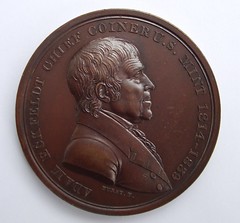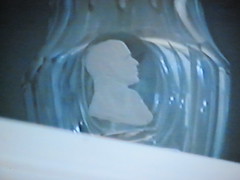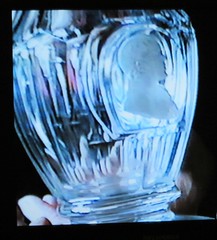
PREV ARTICLE
NEXT ARTICLE
FULL ISSUE
PREV FULL ISSUE
CAMEO INCRUSTATIONS AND THE ADAM ECKFELDT PITCHER
Dick Johnson submitted this marvelous account of how medals were used to make designs in glass.
-Editor
While I cannot tell the Adam Eckfeldt family descendant where her family heirloom pitcher -- bearing the U.S. Mint's first chief coiner's portrait -- is located, or where there is another, I can reveal, however, how it was made. This is one of the more charming USES of medals. For three decades as an employee of a medal manufacturer and later a medal dealer I often encountered naive people who asked. "What good are medals? What do you do with them?" Over the years I developed a pat answer: "They provide longevity. They reveal something that happened in the past." Depending upon how long I could hold their attention I would continue talking about portraits of people long past, and events that are more accurate than historians -- or history books. And about the artists who created the medals -- engravers first, later sculptors working in clay models. And the beauty of medallic art. And ... If they hadn't walked away from me by them I could keep on talking about how the artist's clay models are cast in plaster, then a metal shell -- a galvano -- is made from that plaster, then the metal pattern is mounted on a die-engraving pantograph to cut a die the size of the intended medal. Then ... I could still go on ... you see, I was a paid hack to talk about medals (although the title was "publicity director!"). Well, if your lady correspondent hasn't stopped reading this by now, perhaps she would like to know more about her pitcher and how it got her ancestor's portrait embedded in glass. It's a process called incrustration, and those relief elements in glass are called cameo incrustations. They can appear clear, white, silvery or in full color. For the most part they were portraits or devices taken from medals, usually high-relief medals. But the relief in the glass ends up the exact size as the image on the medal -- no reduction or enlargement (unless it was remodeled).
How made: a negative plaster mold is made of one side of a medal containing the desired image. A special clay-glass paste was used to form a positive cast from this mold; the clay cast would then be trimmed to the exact size of the relief part to be reproduced. The clay could be slightly bent at this time. That is how you could have a flat medal design in a round bottle or cup. The surface of the clay is then treated for the color or transparency of the incrustation. If it was to be clear, it was coated with a molten glass substance; if silver was wanted, it would be coated with silver dye; if in full color it could have to be painted. Should the clay be left untreated a small portion of its surface would adhere to the glass object and take the color of the baked clay, somewhat of a chalky color. The treated clay was then positioned in the mold for the glass object. The mold was most often of several parts and would be assembled into place. Molten glass is poured into the mold containing the clay relief. After the object had cooled the mold would be disassembled, the object was removed. The clay would be broken away and discarded. Only the treated surface containing the image would adhere to the glass object. It would appear in three dimensions (more accurately, in relief) and contain the color or clearness desired.


I have written about this unusual utilization of medals in The E-Sylum before (vol 10, no 31, art 11, August 5, 2007). I mentioned the major collection of these glass objects in the collections of the Corning Museum of Glass in Corning New York. Well worth the trip to visit. Also the thrill for collectors is to do exactly what was illustrated in the article last week, match up the medal with the cameo incrustation. That's a thrill for all! I also mentioned the best book on the subject: Jokelson, Sulphides, 1968. Also Dunlap. The Jokelson Collection of Cameo Incrustations. 1991. Alan V. Weinberg writes:
M.A.D. is the Wall Street Journal, the New York Times, the Coin World of the antique trade and collector world. It's issued once a month, is quite voluminous and is well known for publishing pictures and summaries of stolen , missing or descendant searches for a particular item. If the vase is out there or was seen, M.A.D. will uncover it.
DONE. Great idea - she has already contacted M.A.D.
-Editor
To read the earlier E-Sylum articles, see:
MISSING ADAM ECKFELDT PITCHER SOUGHT
(www.coinbooks.org/esylum_v15n07a08.html)
The Numismatic Bibliomania Society is a non-profit organization promoting numismatic literature. See our web site at coinbooks.org. To submit items for publication in The E-Sylum, write to the Editor at this address: whomren@gmail.com To subscribe go to: https://my.binhost.com/lists/listinfo/esylum All Rights Reserved. NBS Home Page Contact the NBS webmaster 
|

